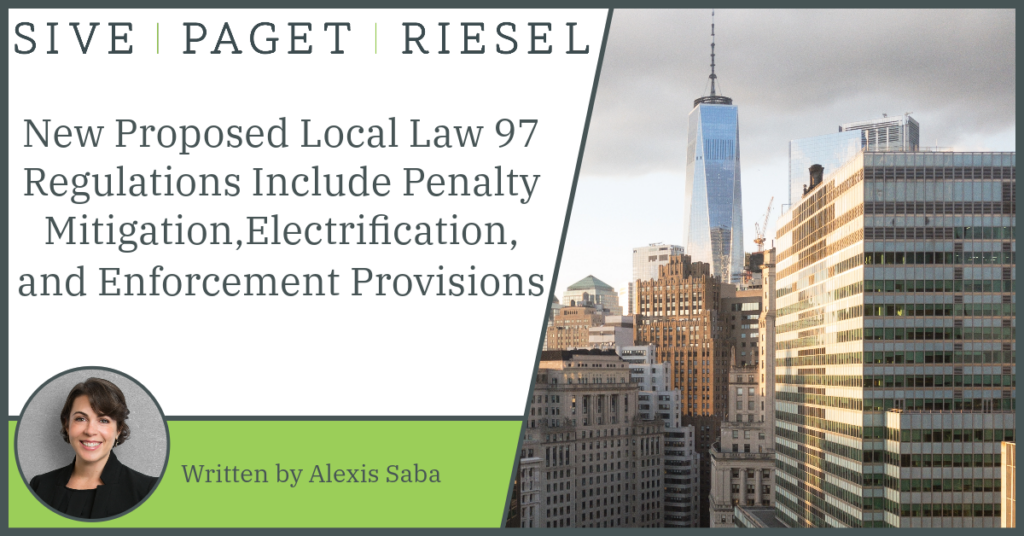Blog

New Proposed Local Law 97 Regulations Include Penalty Mitigation, Electrification, and Enforcement Provisions
On September 12, 2023, the New York City Department of Buildings (DOB) issued proposed regulations to implement Local Law 97 of 2019 (LL97). LL97 requires most large buildings in NYC to meet increasingly stringent greenhouse gas (GHG) emissions limits starting in 2024. The proposed regulations establish penalty mitigation pathways, create incentives for electrification, and clarify the mechanics of enforcement. The proposed regulations also describe the reporting requirements for rent-regulated accommodations and other buildings installing energy conservation measures (ECMs). DOB is accepting public comments on the proposed rules through October 24 and will hold a public hearing online that morning.
The keystone of the proposed regulations is a suite of penalty mitigation options for building owners who undertake good faith efforts to comply with the law. While these provisions provide theoretical compliance relief, they may not go far enough for certain building owners. The amount of the potential penalty mitigation is undefined, and the mitigation options come with stringent requirements that only building owners who are already on the compliance pathway will be able to meet. Further, the penalty mitigation is only available for the 2024-2029 compliance period, although DOB advises that future mitigation options will likely follow a similar framework.
There are six ways to demonstrate good faith compliance, as long as a building owner submits its annual LL97 compliance report, uploads its Local Law 84 benchmarking information, and affirms that the building completed the Local Law 88 lighting upgrades and tenant sub-metering. Demonstration of any one of the good faith compliance efforts may result in penalty mitigation, but the proposed regulations do not specify whether building owners who fulfill more than one category will receive additional penalty mitigation.
First, a building owner can submit a decarbonization plan that includes an energy audit and a schedule and capital plan for building retrofits that will result in compliance with the building’s emissions limits through 2050. By submitting a decarb plan, building owners effectively receive an additional two years to comply with the 2024 emissions limits: within 24 months of submission of the decarb plan, a building owner must demonstrate that the work to comply with the building’s 2024 emissions limit is complete. Notably, a decarb plan cannot include the use of renewable energy credits (RECs).
Three of the good faith penalty mitigation options require building owners to demonstrate that they have already started compliance work by submitting: (1) evidence that DOB has approved an application for work necessary to meet the 2024-2029 emissions limit, with a timeline for implementation; (2) evidence that the building is undergoing electrification, including an approved electrical alteration application and utility certification; or (3) evidence that the building owner submitted a compliance report during the 2024-2029 compliance period demonstrating compliance with the building’s emissions limit for the submission year.
The fifth good faith penalty mitigation option is available to critical facilities such as hospitals that document how penalty payments would impact facility operations. The sixth option is available to buildings that have applied for a financial hardship adjustment by DOB pursuant to NYC Administrative Code § 28-320.7. DOB has not yet issued regulations or opened an application period for this adjustment, but the standards described in LL97 are stringent, including demonstration that the building owner has applied for all available incentives.
In addition to providing a penalty mitigation option for buildings undergoing electrification, the proposed regulations further incentivize electrification by allowing building owners to (1) segregate the electricity consumed by electric-based heating, cooling, and domestic hot water systems from the building’s overall electricity use; and (2) apply a negative GHG coefficient to the electricity consumed by the electric-based equipment, instead of applying the positive GHG coefficient otherwise assigned to utility electricity. Building owners can then bank the accrued emissions savings for future use.
For building owners facing LL97 penalties, the proposed regulations outline for the first time the enforcement procedures that DOB will use. DOB will issue an administrative summons that describes the violation and the penalty amount. Should a building owner decide not to pay the penalty or not provide proof that the violation has been corrected, the matter will be adjudicated before the Office of Administrative Trials and Hearings (OATH). The proposed regulations provide that DOB may offer a mediated resolution where the building owner has submitted an annual compliance report and demonstrated good faith efforts to meet the building’s emissions limits.
As previously set forth in LL97, some building types, such as rent-regulated buildings and houses of worship, are not required to meet the 2024 GHG emissions limits but can instead choose to install certain energy conservation measures (ECMs) enumerated in LL97. The statute requires installation of ECMs “where applicable;” however, the proposed regulations explain that building owners must install each ECM by December 31, 2024, and have the installation inspected and documented by a qualified retro-commissioning agent. The penalty for failure to install the ECMs is $10,000 per building, although building owners can seek mitigation of the penalty based on unexpected events (such as severe flooding or a fire) or a commitment from a government agency for energy conservation rehabilitation project assistance. DOB may also offer a mediated resolution that could include suspended penalties and the requirement to submit a LL97 compliance plan.
While this blog post summarizes the most significant components of the proposed regulations, readers should consult the text of the proposed regulations for details and contact Sive, Paget & Riesel with any questions.